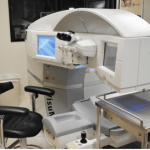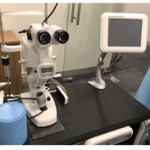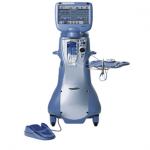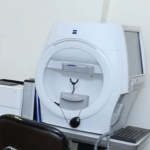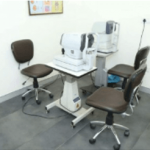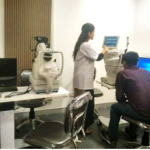Phaco Surgery
FREE Tele-Consultation
Book Appointment or Video Consultation online with top eye doctors
Phaco Surgery
“Phacoemulsification cataract surgery” is a modern technique for the removal of “Cataract”. It can be defined as a surgical procedure, in which the cloudy lens is first broken up and then removed from the eye, with the assistance of an ultrasonic device. In the initial stages of “Cataract”, a person starts to see his retina becoming slightly clouded. Because in the beginning, a very slight section of the lens is affected. But with the advancement of time, Cataract starts to become a more and more severe problem, as the cloudiness of the lens keeps increasing, which ultimately leads to a more and more depleted vision.
The Procedure Of “Phacoemulsification Cataract Surgery”
An eye surgeon begins the surgery by giving a pre-determined amount of “Local anesthesia” or “Topical anesthesia” to the patient. Then a precise and small surgical incision is made on the cornea’s edge, which creates an entrance via the membrane surrounding the lens. After that a compact ultrasonic probe is inserted into the entrance to split up the “cloudy lens”, into numerous small pieces with the application of sound waves. This sound wave performs the function of “microscopic gavel”. The ultrasonic probe has an attachment, which serves the purpose of picking up shattered cataract pieces. After the successful removal of the cloudy lens, the intraocular lens (IOL) is carefully placed in the eye’s natural lens capsule.The process of “Phacoemulsification cataract surgery” was developed by Charles Kelman in the late 1960s, to ensure that the removal of a cataract is done with less amount of pain. There is no requirement of any kind of stitches after the surgery has been performed but in certain cases, an eye shield is recommended by the eye surgeon to the patient. The entire procedure is not very long and only takes a total of 30 minutes. Different kinds of techniques are used by different surgeons for the procedure, with all the procedures being dependent on the actual size of the cataract and it’s density. The different approaches used by eye surgeons for “Phacoemulsification cataract surgery” are entirely based on two factors. The first factor is the specific section of the nucleus, on which an eye surgeon has placed his complete focus.
The second factor is entirely dependent on the way, an eye surgeon has decided to emulsify the cataract. One of the approaches to this form of surgery is known as “Phaco flip”, in which the eye surgeon inverts and rotates the lens for removal. As “Phacoemulsification cataract surgery” is seeing tremendous advancements in it’s technology, it has been speculated that the incision size will be reduced to a considerable extent.
Diagnosis And Preparation
The problem of cataract becomes more and more severe with the progression of time. A person must always be on the lookout for symptoms such as the onset of a blurry vision, depleting central vision, extreme sensitivity to lights, development of a poor vision when placing the focus on nearby things, reduced vision in sunlight.
An eye specialist does not recommend the option of “Phacoemulsification cataract surgery” to the patient diagnosed with cataract if he is in the initial stages rather the patient would be recommended to use a specific set of eyeglasses to treat the clouding of the lens. But if the lens cloudiness keeps increasing with the advancing time, then surgery will become the requirement for the concerned individual, after a thorough eye exam has been performed by the eye specialist. The eye exam of the patient must include the computation of “visual acuity”, under both low and high lightning. There should also be a thorough check-up of the dilation of the pupils, quantification of intraocular pressure (IOP). In some peculiar cases, where a person is diagnosed with the condition of cataract in both eyes. Under such circumstances, both eyes are treated separately the eye specialist. The patient must avoid the intake of any kind of food or liquid, at least 12 hours prior to the surgery. Before the commencement of “Phacoemulsification cataract surgery”, the eye surgeon will also run some additional pre-surgical test on the patient to detect any kind of issue, which can become a hindrance to a successful surgery. The pre-surgical test may include “chest x-ray, blood work, or urinalysis”.
Post-Surgical Care
After the surgery has been performed successfully, the patient is taken to the post-operative care unit. The patient is also advised to ensure that his intake of any kind of food is comprised of light meals only. The patient is bound to feel some amount of eye pain or discomfort after the surgery but that usually goes away after a certain period of time. The eye surgeon can also recommend certain medications for pain relief. When the patient has taken rest for a recommended number of days, then he will be required to pay a visit to his eye surgeon for removal of the eye shield. Patients are also advised to refrain from rubbing their eyes for a period of at least two weeks. After the patient’s eye(s) has healed properly, he may be required to wear corrective glasses, which will assist him with close vision but the required period to wear the glasses is not very long.
Most patients restore proper vision after the “Phacoemulsification cataract surgery”. And also gain a better and enhanced vision, with the continuation of their day to day activities. The blindness rate among people suffering from cataract has been significantly reduced by “Phacoemulsification cataract surgery” with it’s advanced technology. A large stratum of eye specialists consider it a more safer form of cataract surgery in comparison to other kinds of cataract surgeries. Our esteemed team of medical professionals at EyeMantra, provides comprehensive post-surgical care to the patient.
World Class Facilities
